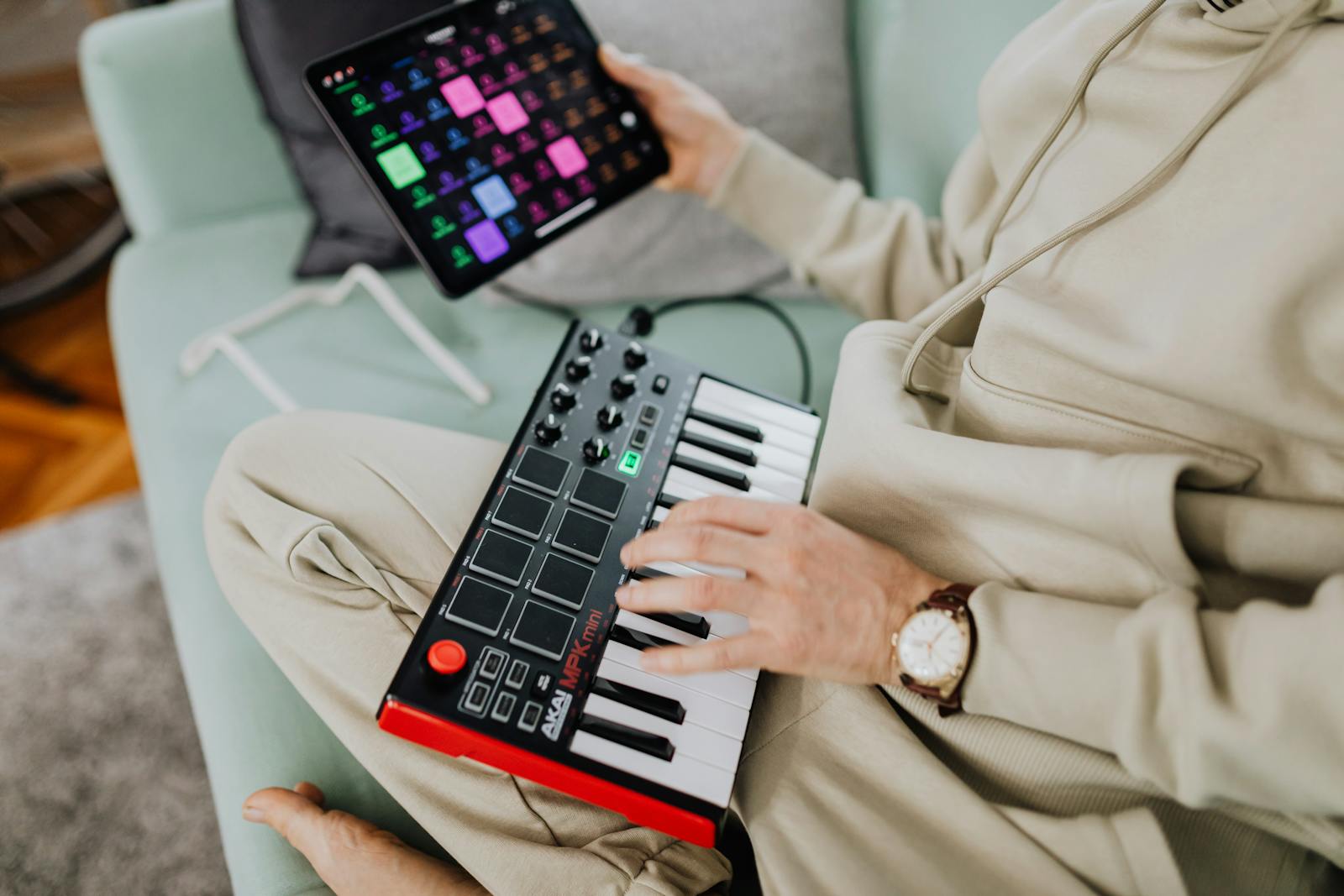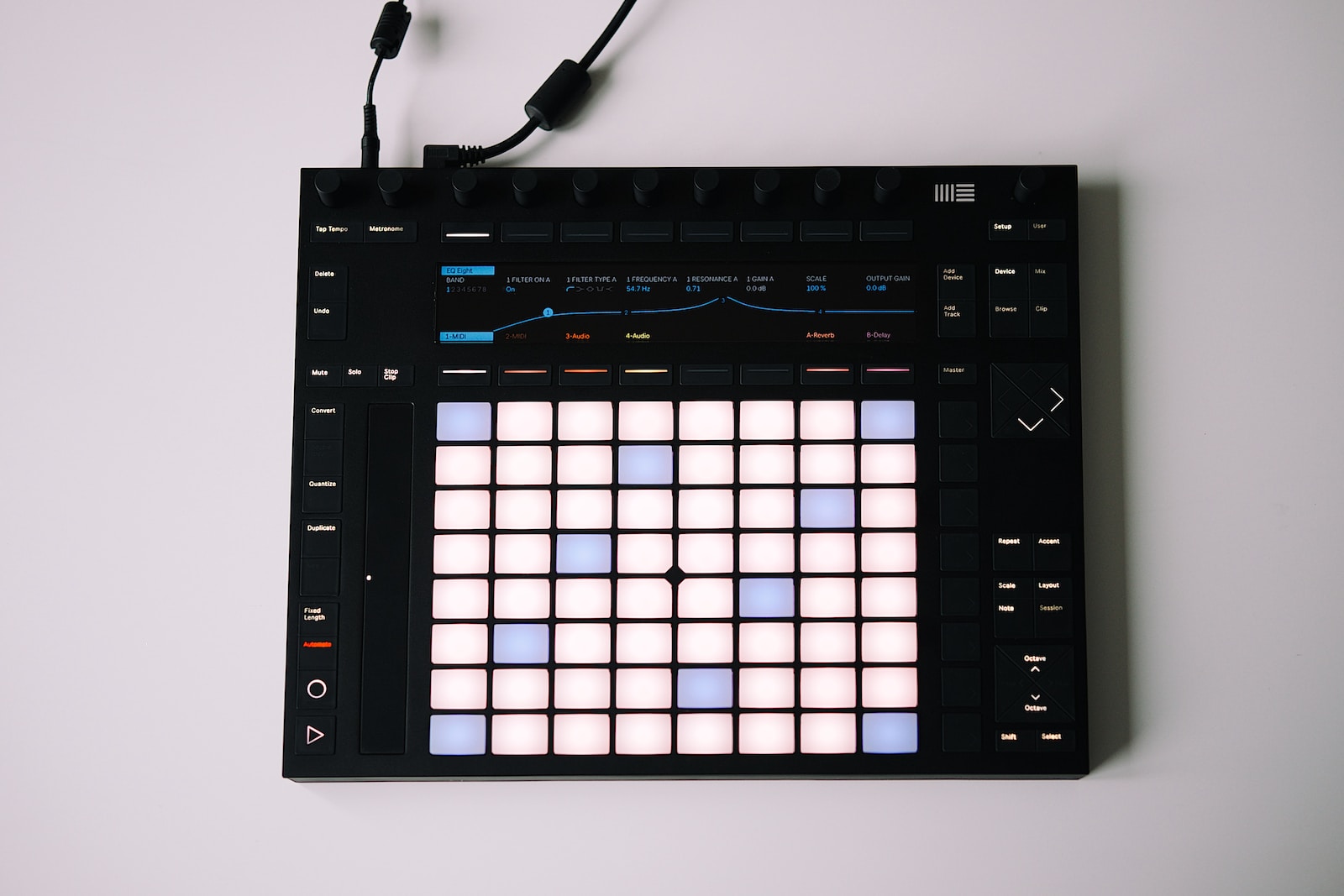
There are many different shapes of MIDI controllers, each with its own unique set of features and advantages. Here are a few examples:
- Keyboard controllers: Keyboard controllers are a popular choice for musicians and producers because they can replicate the feel and sound of a traditional piano. They typically include velocity-sensitive keys that can detect the force of your keystrokes, which can be useful for creating expressive performances. Many keyboard controllers also feature additional controls, such as knobs, sliders, and drum pads, which can be assigned to control different MIDI messages.
- Pad controllers: Pad controllers are often used for beat-making and drum programming, and can be a great tool for creating rhythmic patterns and loops. The pads are pressure-sensitive, which means you can control the volume and other parameters of each sound by adjusting how hard you hit the pads. Some pad controllers also feature additional controls, such as knobs and sliders, which can be used to tweak the sounds further.
- Button controllers: Button controllers are typically used for triggering MIDI notes or chords, and can be a great tool for live performance and DJing. They are often smaller and more portable than other types of MIDI controllers, which makes them easy to take on the road.
- Fader controllers: Fader controllers are designed to control various parameters, such as volume, pan, and effects. They typically include several sliding controls that can be assigned to different functions within your software or hardware setup. Fader controllers can be a useful tool for mixing and mastering your music, allowing you to make precise adjustments to your tracks.
- Ribbon controllers: Ribbon controllers are a unique type of MIDI controller that feature a long, narrow ribbon that can be manipulated to generate different MIDI messages. The ribbon can be pushed, pulled, or bent to create different effects, such as pitch bend or modulation. Ribbon controllers can be a great tool for adding expressive elements to your music, and can be especially useful for creating realistic string and wind instrument sounds.
- Wind controllers: Wind controllers are designed to be played like traditional woodwind instruments, such as a saxophone or clarinet. They typically include a mouthpiece and sensors that detect breath and finger movements to produce MIDI messages. Wind controllers can be a great tool for adding expressive and realistic wind instrument sounds to your music, and can be a lot of fun to play.
- Guitar controllers: Guitar controllers are designed to be played like a guitar, with sensors that detect finger movements on the fretboard and strings. They can be a great tool for creating realistic guitar sounds and performances, and can be especially useful for producers and composers who don’t play guitar themselves.
- DJ controllers: DJ controllers are designed specifically for DJing, with features such as jog wheels, pitch sliders, and crossfaders that allow DJs to manipulate and mix tracks in real time. DJ controllers can be a great tool for both novice and experienced DJs, and can help you create exciting and dynamic sets.

Other than those commonly found, there are many other types of MIDI controllers. Here are a few additional examples:
- Electronic drums: Electronic drum kits are MIDI controllers that can be used to trigger drum sounds in a digital audio workstation (DAW) or drum machine. Each drum pad on the kit is typically assigned to a different MIDI note, allowing you to create realistic drum performances using MIDI. Electronic drums can be a great tool for drummers and producers who want to create realistic drum tracks without the expense and setup time of traditional acoustic drum kits.
- Breath controllers: Breath controllers are similar to wind controllers in that they allow you to control MIDI messages using breath and mouth movements. However, they typically do not include a traditional instrument interface, and are instead designed to be used with a mouthpiece or other breath input device. Breath controllers can be a great tool for adding expressive elements to your music, and can be especially useful for creating realistic brass and woodwind instrument sounds.
- Foot controllers: Foot controllers are MIDI controllers that are designed to be operated with your feet, rather than your hands. They can include pedals, buttons, and other types of switches that can be assigned to different MIDI messages. Foot controllers can be a great tool for guitarists, keyboard players, and other musicians who need to keep their hands free while performing.
- Motion controllers: Motion controllers are a newer type of MIDI controller that use sensors to detect your movements and translate them into MIDI messages. They can include accelerometers, gyroscopes, and other types of sensors that can detect motion, orientation, and position. Motion controllers can be a great tool for adding expressive elements to your music, and can be especially useful for creating ambient and experimental sounds.
- Touch controllers: Touch controllers are MIDI controllers that use touch-sensitive surfaces to detect your movements and translate them into MIDI messages. They can include touchscreens, touchpads, and other types of surfaces that can detect touch, pressure, and other movements. Touch controllers can be a great tool for creating complex and dynamic performances, and can be especially useful for live performance and improvisation.
Overall, there are many different types of MIDI controllers available, each with its own unique set of features and advantages. Choosing the right MIDI controller depends on your specific needs and preferences as a musician or producer.










































































































